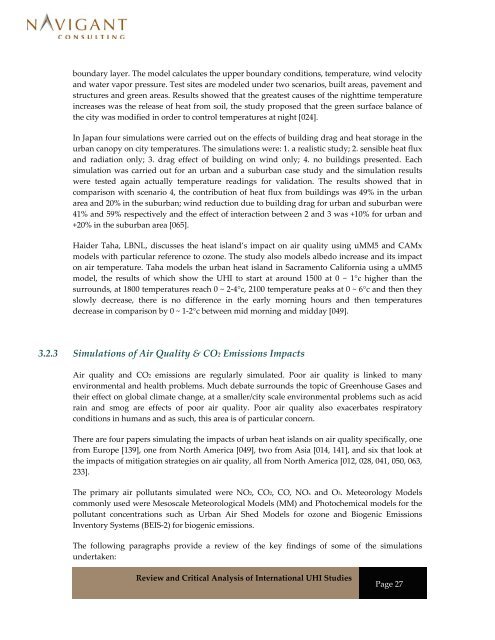Review and Critical Analysis of International UHI Studies
Review and Critical Analysis of International UHI Studies
Review and Critical Analysis of International UHI Studies
You also want an ePaper? Increase the reach of your titles
YUMPU automatically turns print PDFs into web optimized ePapers that Google loves.
oundary layer. The model calculates the upper boundary conditions, temperature, wind velocity<br />
<strong>and</strong> water vapor pressure. Test sites are modeled under two scenarios, built areas, pavement <strong>and</strong><br />
structures <strong>and</strong> green areas. Results showed that the greatest causes <strong>of</strong> the nighttime temperature<br />
increases was the release <strong>of</strong> heat from soil, the study proposed that the green surface balance <strong>of</strong><br />
the city was modified in order to control temperatures at night [024].<br />
In Japan four simulations were carried out on the effects <strong>of</strong> building drag <strong>and</strong> heat storage in the<br />
urban canopy on city temperatures. The simulations were: 1. a realistic study; 2. sensible heat flux<br />
<strong>and</strong> radiation only; 3. drag effect <strong>of</strong> building on wind only; 4. no buildings presented. Each<br />
simulation was carried out for an urban <strong>and</strong> a suburban case study <strong>and</strong> the simulation results<br />
were tested again actually temperature readings for validation. The results showed that in<br />
comparison with scenario 4, the contribution <strong>of</strong> heat flux from buildings was 49% in the urban<br />
area <strong>and</strong> 20% in the suburban; wind reduction due to building drag for urban <strong>and</strong> suburban were<br />
41% <strong>and</strong> 59% respectively <strong>and</strong> the effect <strong>of</strong> interaction between 2 <strong>and</strong> 3 was +10% for urban <strong>and</strong><br />
+20% in the suburban area [065].<br />
Haider Taha, LBNL, discusses the heat isl<strong>and</strong>’s impact on air quality using uMM5 <strong>and</strong> CAMx<br />
models with particular reference to ozone. The study also models albedo increase <strong>and</strong> its impact<br />
on air temperature. Taha models the urban heat isl<strong>and</strong> in Sacramento California using a uMM5<br />
model, the results <strong>of</strong> which show the <strong>UHI</strong> to start at around 1500 at 0 ~ 1°c higher than the<br />
surrounds, at 1800 temperatures reach 0 ~ 2‐4°c, 2100 temperature peaks at 0 ~ 6°c <strong>and</strong> then they<br />
slowly decrease, there is no difference in the early morning hours <strong>and</strong> then temperatures<br />
decrease in comparison by 0 ~ 1‐2°c between mid morning <strong>and</strong> midday [049].<br />
3.2.3 Simulations <strong>of</strong> Air Quality & CO2 Emissions Impacts<br />
Air quality <strong>and</strong> CO2 emissions are regularly simulated. Poor air quality is linked to many<br />
environmental <strong>and</strong> health problems. Much debate surrounds the topic <strong>of</strong> Greenhouse Gases <strong>and</strong><br />
their effect on global climate change, at a smaller/city scale environmental problems such as acid<br />
rain <strong>and</strong> smog are effects <strong>of</strong> poor air quality. Poor air quality also exacerbates respiratory<br />
conditions in humans <strong>and</strong> as such, this area is <strong>of</strong> particular concern.<br />
There are four papers simulating the impacts <strong>of</strong> urban heat isl<strong>and</strong>s on air quality specifically, one<br />
from Europe [139], one from North America [049], two from Asia [014, 141], <strong>and</strong> six that look at<br />
the impacts <strong>of</strong> mitigation strategies on air quality, all from North America [012, 028, 041, 050, 063,<br />
233].<br />
The primary air pollutants simulated were NO2, CO2, CO, NOx <strong>and</strong> O3. Meteorology Models<br />
commonly used were Mesoscale Meteorological Models (MM) <strong>and</strong> Photochemical models for the<br />
pollutant concentrations such as Urban Air Shed Models for ozone <strong>and</strong> Biogenic Emissions<br />
Inventory Systems (BEIS‐2) for biogenic emissions.<br />
The following paragraphs provide a review <strong>of</strong> the key findings <strong>of</strong> some <strong>of</strong> the simulations<br />
undertaken:<br />
<strong>Review</strong> <strong>and</strong> <strong>Critical</strong> <strong>Analysis</strong> <strong>of</strong> <strong>International</strong> <strong>UHI</strong> <strong>Studies</strong><br />
Page 27


